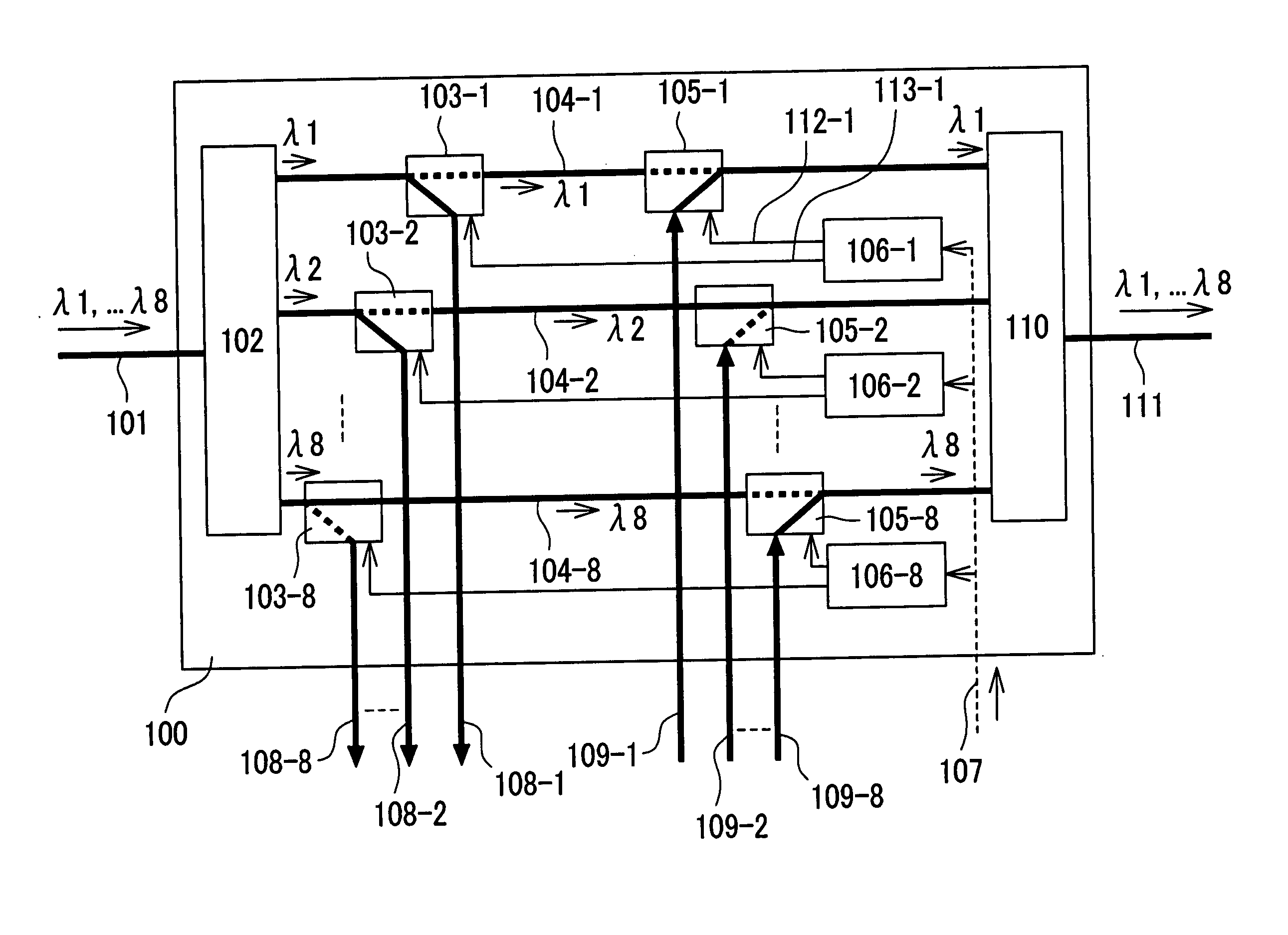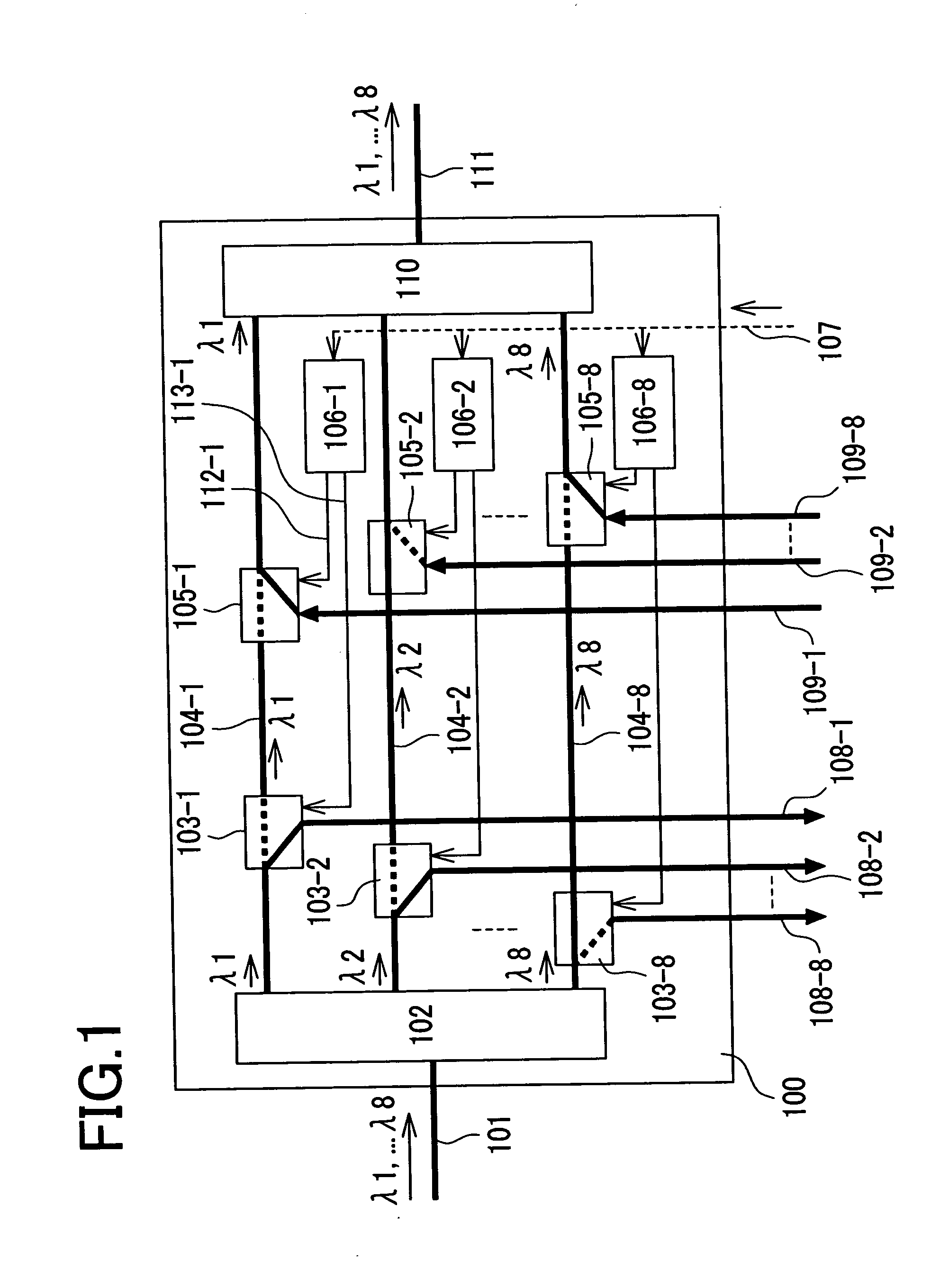Optical add-drop multiplexer, and optical network equipment using the same
a technology of optical network equipment and multiplexers, applied in multiplex communication, transmission monitoring, electromagnetic repeaters, etc., can solve the problems of increased equipment cost, extra space for accommodating boards, and extra time until services are provided, so as to increase failure resistance, high functionality, and high cost
- Summary
- Abstract
- Description
- Claims
- Application Information
AI Technical Summary
Benefits of technology
Problems solved by technology
Method used
Image
Examples
first embodiment
[0052]FIG. 1 is a schematic view illustrating a first embodiment according to the present invention. FIG. 1 illustrates an example of how an optical add-drop multiplexer (OADM) 100 according to the present invention is configured. The optical add-drop multiplexer 100 according to the present invention is located between an input WDM optical fiber line 101 and an output WDM optical fiber line 111. An inputted wavelength-division multiplexed signal having eight wavelengths λ1 through λ8 is separated and passed into through signal paths 104-1 through 104-8 on a wavelength basis by an optical wavelength demultiplexer 102. After that, the separated signals are wavelength-division multiplexed by an optical wavelength multiplexer 110 again, and this wavelength-division multiplexed signal is then output.
[0053] 1×2 optical switches (drop switches) 103-1 through 103-8 used to set a drop state of an optical signal, and 2×1 optical switches (add switches) 105-1 through 105-8 used to set an add...
second embodiment
[0071]FIG. 4 is a schematic view illustrating a second embodiment of the present invention. FIG. 4 illustrates the configuration of a node 124-1 in which a failure detection circuit 135 is built into an optical add-drop multiplexer according to the present invention, and in which a two-output two-input optical transceiver 138 is used. In this example, part of an optical signal corresponding to each wavelength output from the optical wavelength demultiplexers 102-1, 102-2 is dropped, and is then introduced into the failure detection circuit 135. Failure information of the active signal line, which has been detected by the active-side failure detection circuit 135-1 corresponding to the wavelength λ1, is branched into two. Then, both of the branched failure information are inputted into the active-side and backup-side optical switch control circuits 106-1, 106-2 corresponding to the wavelength λ1 respectively. Likewise, failure information of the backup signal line, which has been det...
third embodiment
[0076]FIG. 8 is a diagram illustrating a third embodiment of the present invention. FIG. 8 illustrates an example in which 1:1 optical protection is implemented in a two-fiber ring network according to the present invention. The configuration in a transmission node 124-1-and that in a receiving node 125-1 are the same as the configuration of the 1+1 optical protection shown in FIG. 2. According to the present invention, it is possible to select an arbitrary optical protection mode if necessary by changing settings of software.
[0077] The 1:1 optical protection adopts a mode in which an optical signal is transmitted to only a normal optical fiber line on the transmission side. In a normal state, as shown in FIG. 19, an add switch corresponding to the wavelength λ1 in the active-side optical add-drop multiplexer 130-1 included in the transmission node 124-1 is set to an add state; and an add switch corresponding to the wavelength λ1 in the backup-side optical add-drop multiplexer 131-...
PUM
 Login to View More
Login to View More Abstract
Description
Claims
Application Information
 Login to View More
Login to View More - R&D
- Intellectual Property
- Life Sciences
- Materials
- Tech Scout
- Unparalleled Data Quality
- Higher Quality Content
- 60% Fewer Hallucinations
Browse by: Latest US Patents, China's latest patents, Technical Efficacy Thesaurus, Application Domain, Technology Topic, Popular Technical Reports.
© 2025 PatSnap. All rights reserved.Legal|Privacy policy|Modern Slavery Act Transparency Statement|Sitemap|About US| Contact US: help@patsnap.com



